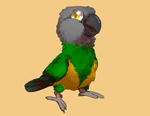 Kili
Type: Senegal Parrot
Genus: Poicephalus
Species: Senegalus
Subspecies: Mesotypus
Sex: Female
Weight: 120 grams
Height: 9 inches
Age: 15 years, 11 months
|
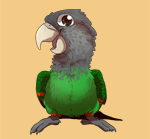 Truman
Type: Cape Parrot
Genus: Poicephalus
Species:Robustus
Subspecies: Fuscicollis
Sex: Male
Weight: 330 grams
Height: 13 inches
Age: 14 years, 2 months
|
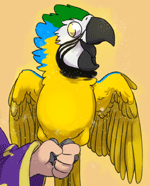 Rachel
Type: Blue & Gold Macaw
Genus: Ara
Species:ararauna
Sex: Female
Weight: 850 grams
Height: 26 inches
Age: 11 years, 11 months
|
List of Common Parrots:
Parakeets:
Budgerigar (Budgie)
Alexandrine Parakeet
African Ringneck
Indian Ringneck
Monk Parakeet (Quaker Parrot)
Parrotlets:
Mexican Parrotlet
Green Rumped Parrotlet
Blue Winged Parrotlet
Spectacled Parrotlet
Dusky Billed Parrotlet
Pacific Parrotlet
Yellow Faced Parrotlet
Lovebirds:
Peach Faced Lovebird
Masked Lovebird
Fischer's Lovebird
Lilian's (Nyasa) Lovebird
Black Cheeked Lovebird
Madagascar Lovebird
Abyssinian Lovebird
Red Faced Lovebird
Swindern's Lovebird
Lories and Lorikeets:
Rainbow Lorikeet
Conures:
Sun Conure
Jenday Conure
Cherry Headed Conure
Blue Crowned Conure
Mitred Conure
Patagonian Conure
Green Cheeked Conure
Nanday Conure
Caiques:
Black Headed Caique
White Bellied Caique
Poicephalus Parrots:
Senegal Parrot
Meyer's Parrot
Red Bellied Parrot
Brown Headed Parrot
Jardine's Parrot
Cape Parrot
Ruppell's Parrot
Eclectus:
Eclectus Parrot
African Greys:
Congo African Grey (CAG)
Timneh African Grey (TAG)
Amazons:
Blue Fronted Amazon
Yellow Naped Amazon
Yellow Headed Amazon
Orange Winged Amazon
Yellow Crowned Amazon
Cockatoos:
Cockatiel
Galah (Rose Breasted) Cockatoo
Sulphur Crested Cockatoo
Umbrella Cockatoo
Moluccan Cockatoo
Bare Eyed Cockatoo
Goffin's Cockatoo
Macaws:
Red Shouldered (Hahn's) Macaw
Severe Macaw
Blue And Gold Macaw
Blue Throated Macaw
Military Macaw
Red Fronted Macaw
Scarlet Macaw
Green Winged Macaw
Hyacinth Macaw
Glossary of Common Parrot Terms
|
Parrots are extremely intelligent creatures and can learn concepts like colors, matching, and size. That's why I am always excited to teach tricks to my parrots that both challenge them and demonstrate their capabilities to others.
It was pretty easy to teach my new Colored Boxes trick to Kili. That is because she already has all of the skills required to learn the colored boxes trick. First, a parrot needs to know how to fetch. Next, the parrot needs to learn how to match colors. Finally, the parrot needs to learn how to push or pull.
Kili already learned how to match colors in the puzzle trick and ring toss trick. Kili learned to push/pull for a coin box trick and for her stroller trick. Putting all of these skills together led to the Colored Boxes trick. In this trick Kili places all of the round colored pieces into matching colored boxes. Some of the pieces are smaller and some are larger. She had to learn to ignore the size and focus exclusively on matching the colors. Then Kili learned to walk over and push all of the boxes closed.
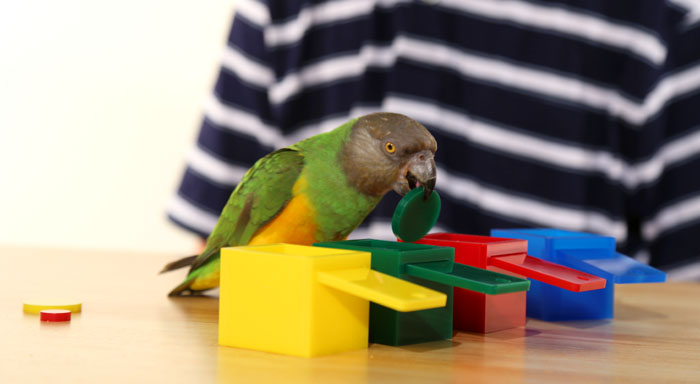
A problem that I ran into while teaching this trick was that Kili tricked me into helping her figure out where to put the pieces. Out of habit, I was clicking my clicker during the moment Kili would begin to dip the piece into right box. I realized that she would walk around dipping the piece into each box and waiting to see if there would be a click or not. In other words, she was tricking me into determining the color match and just cuing her when to drop it. So to avoid being outsmarted by the bird, I had to pay attention not to click until she would fully release the piece into the right box. She needed to receive the negative punishment of getting nothing for dropping the pieces into the wrong boxes in order to realize which ones are actually right.
When you teach a color match trick like ring toss, puzzle, or colored boxes, in the beginning the bird will only do two or three colors on pure memorization. But as you keep increasing the number of colors, a light bulb comes on in that bird's head and it realizes that the colors have to match regardless of what they are. Then the bird is able to match any color of that style trick.
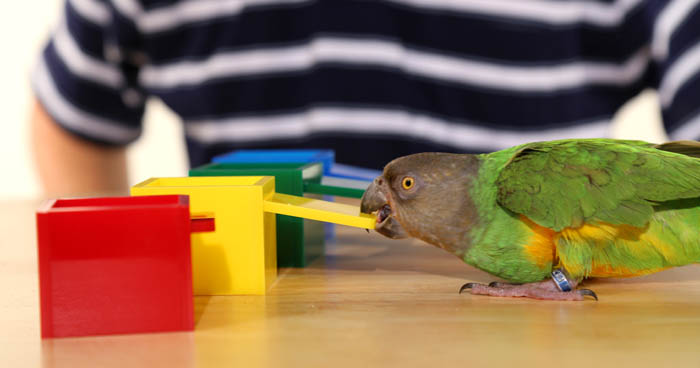

I recommend the Colored Boxes Trick for any small to medium parrots. It's too small for bigger parrots but the 6 Color Birdie Ring Toss is great for all the medium to large parrots.
Now check out this video of Kili performing her colored boxes trick:
|
Here is a video where Kili and Truman do interviews of different people around Central Park in New York City and what they know about parrots.
|
Oh no! The Parrot Got Out! This is the newest video posted by Parrot Wizard, a short Horror Film about what might happen if the psitta-beast got out of its enclosure. The short film features Marianna Samushiya and the well-known trained Senegal Parrot, Kili. Marianna comes home but soon realizes that she's being followed.
It took several days of filming and even more of editing but I am pleased with the results. I used a mix of techniques to bring you the story and action. From classic pan shots to steadicam tracking, you will enjoy the heart pumping action and terror.
Here are a few behind the scenes looks at the making of The Parrot Got Out:
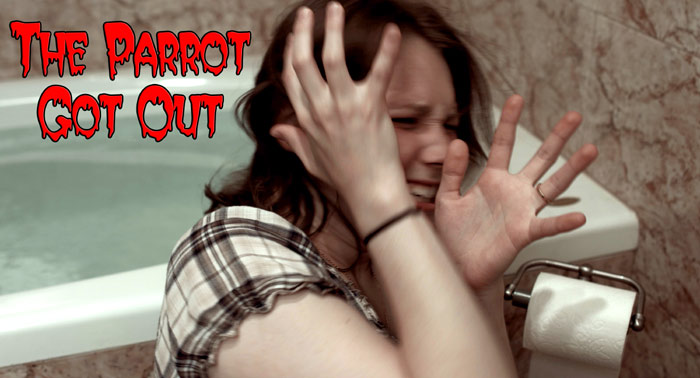

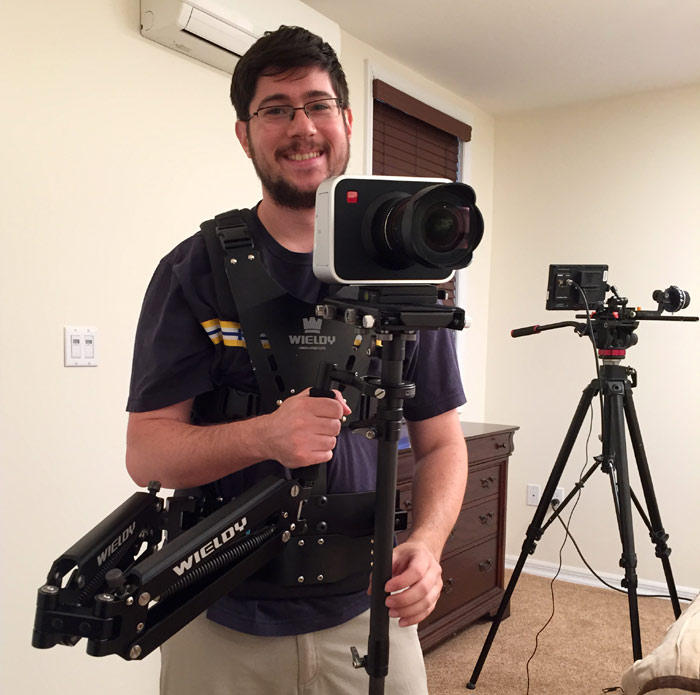
So dim your lights, set youtube to fullscreen, change the play quality to 4K or HD, and get ready to witness the horror of The Parrot Got Out:
|
Check out Kili's newest trick. Well actually it's not that new but we have not made a video about it before. I taught Kili the bird toss or what I like to call "boing boing." It's a trick in which I can toss Kili up and down in my hand like a beanbag.
The trick first came to me when I was walking about Phoenix with Ginger and her Senegal Parrot Sammy on a harness. Sammy is a really easy going Senegal Parrot that just about anyone can hold. Sammy is the star of Ginger's Parrots Movie. Anyway, so I taught Sammy to wear a harness in no time and we went to a Sunday morning parrot outing with other parrot owners. I was holding Sammy and we were there a while so I started turning Sammy over and playing. I forget why exactly but I started bouncing Sammy up and down in my hand and before you knew it we had a new trick.
Ginger and I passed by Dr. Drigger's office (a well known Avian Veterinarian in the Phoenix area) and I showed him what Sammy could do. The doc thought it was hysterical and took a video.
Fast forward to more recent times. Kili is very good about laying in my hand. So I started preparing her for the bird toss. At first it was just a matter of moving my hand up and down while holding her. But then I started letting go and allowing her to go up out of my hand a little and back down. It's nothing more than a trust building exercise. If Kili gets too uncomfortable, she just flips over and lands on my hand or flies away. But I can see her overcoming her fears in order to earn treats.
The funny thing is that this trick wasn't taught in the usual click and treat method. Instead it would happen here and there in the course of a year. Sometimes just playing with her out of boredom, other times right before putting her in the cage for a meal, little by little Kili learned to bounce like a champ. This was sooner a long term type of training rather than quick accelerated learning. I tried to get her to learn it quickly at first but it just wasn't working. So spanning it out over time without any hurry was the best thing for this type of a trick.
To teach the more basic requisites such as touching, grabbing, and turning your bird over on its back, please refer to my book, The Parrot Wizard's Guide to Well-Behaved Parrots.
An interesting thing I noticed is that both Sammy, Kili, and Truman do better with the bird toss while wearing a harness. Perhaps it's the security they feel of still being partially held (by the harness instead of hand) or something else, but the harness definitely helped get the trick going in the beginning. And without further ado, here's the video:
|
| | Thursday December 18th, 2014 |
|
This article is about giving medication to multiple parrots in a multi-parrot home. For instructions on giving medication to a single (particularly untrained) parrot, I previously wrote about giving medication to my Green-Winged Macaw.
My flock was diagnosed with Clostridium so now they all have to take medication for 21 days. Santina previously had it and received treatment but it did not stop the other birds from catching it as well. It is not clear if it is the food, environment, or other bird that is the cause. But regardless the entire flock needs to be medicated. The medication is administered orally once a day. The trouble is the duration for which it has to be given. This is a long enough of a period that the parrots must be trained to accept medication. Clever trickery may get you by a few days or a week. But anything longer and the parrot must be on board.
In most cases where a parrot requires medication in a multi-parrot home, the rest of the flock should receive the medication even if they don't show symptoms. My birds all seem to have it because they have been having smelly poop.
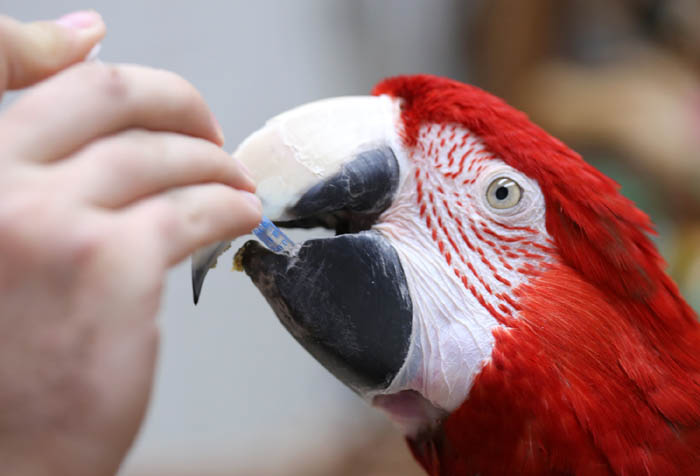
So on to the process of medicating a bunch of birds together. This may seem like a lot of work but actually if done right makes things a heck of a lot easier! Using modeling and a healthy dose of competition can get the birds to be more excited about doing something undesirable (like taking medication)!
I medicate the entire flock together and have turned it into a fun game for them. I have been taking advantage of each of my bird's strong points while avoiding their weaknesses in this medication process. This makes it appear to each of the other birds that the one they are watching really loves getting medication.
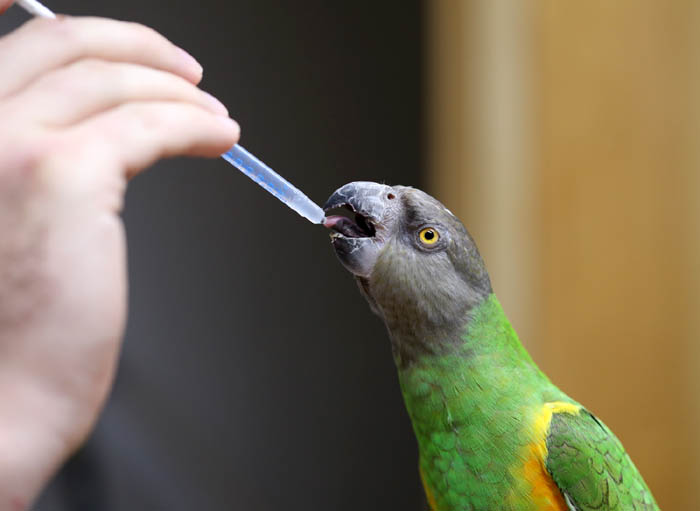
Kili is a super trained parrot so for her I set taking medication to be like a trick. I taught her to target the syringe, then to sip water, and finally to sip and swallow. Thus when I make the unexpected switch to real medication she just takes it. Santina is a great follower. She likes to do what the others are doing. So between the original medication sessions that I had with her modeling off of me and the recent ones of modeling from the other birds, she is doing very well. Truman is a bit of a runt and doesn't want to take medication but I've been working past that with him as well. He drinks water like a camel so I've been letting him get thirsty and then enjoy drinking a lot of water from the syringe. Because each bird appears eager to participate in the medication process (although each for different reasons) it encourages the remaining birds to cooperate and try harder. Nobody wants the competition to get more!
Here are some more elements that have made the process so successful. I practice the "medication process" with just water in the syringe twice a day although medication only comes once. For every 1 sip of medication, the birds are probably getting 40 sips of water. This makes the undesirable medication not only unpredictable but also fairly negligible in the greater scheme of getting water from the syringe. The birds get pellets as treats so this makes them more thirsty for water sips from the syringe. The pellets also soak up medication in their beaks and ensure that it is swallowed. Also I stopped providing water in the cage and have been giving it by hand only to ensure that the birds desire fluids at the necessary time. Spitting out and not receiving the medicine is far worse. So instead I let them sip some of their drinking water from the syringe and the rest they get from a bowl in my hands. This is similar to when we travel so they are perfectly used to it.
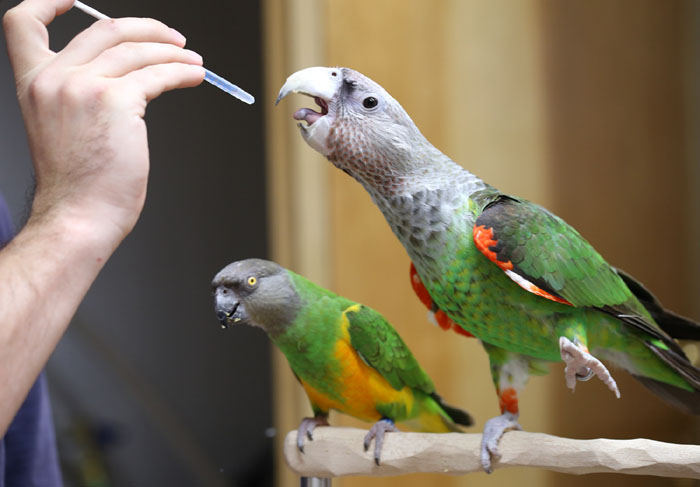
The thirstier/hungrier birds are far less picky. They used to spit out pellets that got medication on them from inside their beaks. Truman in particular would shake his head and spit out the medication. But now with this training system in place, the birds are far more cooperative. With practice, they now know the routine very well and are even more cooperative. In their competition with each other to get water and treats, they seem to forget their resistance to the medication and it is a win/win for everyone.
It is important to understand that the objective is not to simply get the medicine into the bird but to succeed in completing the entire medication process. Tricking or forcing the bird to take medication will only work a few times. In an emergency, you do what you gotta do. But if the bird is in condition to be trained, it is far far better to have a bird that wants to take medication than a bird that flies away or bites you because it knows what is coming. This is why even after the birds get the real medication, I keep practicing with them with the water. In fact, I would say they get the real medication about a quarter of the way into the session. This is when motivation is highest and it makes it least predictable as to when it will happen. Since they all come over to me when they see a syringe, I know I have succeeded in applying positive reinforcement to taking medication!
|
|










 Older Articles
Older Articles  Newer Articles
Newer Articles